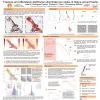Poster #140, Fault and Rupture Mechanics (FARM)
Slip response to fluid depressurization constrains fault friction
Poster Image:

Poster Presentation
2020 SCEC Annual Meeting, Poster #140, SCEC Contribution #10608 VIEW PDF
Fluid injections are ubiquitous in the exploitation of geoenergy resources but can reactivate nearby faults. Whether the ensuing slip is seismic or aseismic and restrained to the fluid-pressurized zone or not is thought to be controlled by the level of quasi-static and dynamic friction relative to initial fault stress. In this study, we investigate the possibility of constraining fault friction with fluid-injection experiments on natural faults without inducing large-scale earthquakes. We first show, using a fully-dynamic rate-and-state friction model, that the slip observed during the pressurization stage of one such field experiment is consistent with a range of frictional scenarios with diverging stability upon sustained injection. We then restrict this range by considering the slip response during the depressurization stage of the experiment: While higher-friction (more stable) scenarios rapidly decelerate, lower-friction (more unstable) models overpredict the observed slip. Our modelling reveals how optimally designed depressurization and spatially distributed monitoring could resolve fault friction and hence stability while suppressing earthquake nucleation at the injection site.

























































